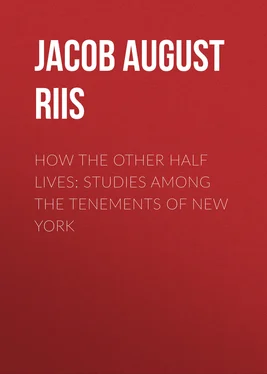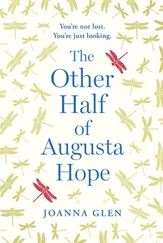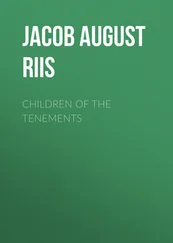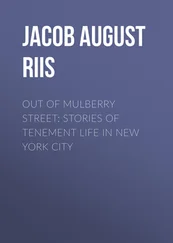Jacob August Riis - How the Other Half Lives - Studies Among the Tenements of New York
Здесь есть возможность читать онлайн «Jacob August Riis - How the Other Half Lives - Studies Among the Tenements of New York» — ознакомительный отрывок электронной книги совершенно бесплатно, а после прочтения отрывка купить полную версию. В некоторых случаях можно слушать аудио, скачать через торрент в формате fb2 и присутствует краткое содержание. Жанр: foreign_prose, sociology_book, foreign_antique, на английском языке. Описание произведения, (предисловие) а так же отзывы посетителей доступны на портале библиотеки ЛибКат.
- Название:How the Other Half Lives: Studies Among the Tenements of New York
- Автор:
- Жанр:
- Год:неизвестен
- ISBN:нет данных
- Рейтинг книги:3 / 5. Голосов: 1
-
Избранное:Добавить в избранное
- Отзывы:
-
Ваша оценка:
- 60
- 1
- 2
- 3
- 4
- 5
How the Other Half Lives: Studies Among the Tenements of New York: краткое содержание, описание и аннотация
Предлагаем к чтению аннотацию, описание, краткое содержание или предисловие (зависит от того, что написал сам автор книги «How the Other Half Lives: Studies Among the Tenements of New York»). Если вы не нашли необходимую информацию о книге — напишите в комментариях, мы постараемся отыскать её.
How the Other Half Lives: Studies Among the Tenements of New York — читать онлайн ознакомительный отрывок
Ниже представлен текст книги, разбитый по страницам. Система сохранения места последней прочитанной страницы, позволяет с удобством читать онлайн бесплатно книгу «How the Other Half Lives: Studies Among the Tenements of New York», без необходимости каждый раз заново искать на чём Вы остановились. Поставьте закладку, и сможете в любой момент перейти на страницу, на которой закончили чтение.
Интервал:
Закладка:
Lest anybody flatter himself with the notion that these were evils of a day that is happily past and may safely be forgotten, let me mention here three very recent instances of tenement-house life that came under my notice. One was the burning of a rear house in Mott Street, from appearances one of the original tenant-houses that made their owners rich. The fire made homeless ten families, who had paid an average of $5 a month for their mean little cubby-holes. The owner himself told me that it was fully insured for $800, though it brought him in $600 a year rent. He evidently considered himself especially entitled to be pitied for losing such valuable property. Another was the case of a hard-working family of man and wife, young people from the old country, who took poison together in a Crosby Street tenement because they were “tired.” There was no other explanation, and none was needed when I stood in the room in which they had lived. It was in the attic with sloping ceiling and a single window so far out on the roof that it seemed not to belong to the place at all. With scarcely room enough to turn around in they had been compelled to pay five dollars and a half a month in advance. There were four such rooms in that attic, and together they brought in as much as many a handsome little cottage, in a pleasant part of Brooklyn. The third instance was that of a colored family of husband, wife, and baby in a wretched rear rookery in West Third Street. Their rent was eight dollars and a half for a single room on the top-story, so small that I was unable to get a photograph of it even by placing the camera outside the open door. Three short steps across either way would have measured its full extent.

TENEMENT OF 1863, FOR TWELVE FAMILIES ON EACH FLAT. 4 4 This “unventilated and fever-breeding structure” the year after it was built was picked out by the Council of Hygiene, then just organized, and presented to the Citizens’ Association of New York as a specimen “multiple domicile” in a desirable street, with the following comment: "Here are twelve living-rooms and twenty-one bedrooms, and only six of the latter have any provision or possibility for the admission of light and air, excepting through the family sitting- and living-room; being utterly dark, close, and unventilated. The living-rooms are but 10 Ã 12 feet; the bedrooms 6½ Ã 7 feet.“
D, dark. L, light. H, halls.
There was just one excuse for the early tenement-house builders, and their successors may plead it with nearly as good right for what it is worth. “Such,” says an official report, “is the lack of house-room in the city that any kind of tenement can be immediately crowded with lodgers, if there is space offered.” Thousands were living in cellars. There were three hundred underground lodging-houses in the city when the Health Department was organized. Some fifteen years before that the old Baptist Church in Mulberry Street, just off Chatham Street, had been sold, and the rear half of the frame structure had been converted into tenements that with their swarming population became the scandal even of that reckless age. The wretched pile harbored no less than forty families, and the annual rate of deaths to the population was officially stated to be 75 in 1,000. These tenements were an extreme type of very many, for the big barracks had by this time spread east and west and far up the island into the sparsely settled wards. Whether or not the title was clear to the land upon which they were built was of less account than that the rents were collected. If there were damages to pay, the tenant had to foot them. Cases were “very frequent when property was in litigation, and two or three different parties were collecting rents.” Of course under such circumstances “no repairs were ever made.”
The climax had been reached. The situation was summed up by the Society for the Improvement of the Condition of the Poor in these words: “Crazy old buildings, crowded rear tenements in filthy yards, dark, damp basements, leaking garrets, shops, outhouses, and stables 5 5 “A lot 50 Ã 60, contained twenty stables, rented for dwellings at $15 a year each; cost of the whole $600.”
converted into dwellings, though scarcely fit to shelter brutes, are habitations of thousands of our fellow-beings in this wealthy, Christian city.” “The city,” says its historian, Mrs. Martha Lamb, commenting on the era of aqueduct building between 1835 and 1845, “was a general asylum for vagrants.” Young vagabonds, the natural offspring of such “home” conditions, overran the streets. Juvenile crime increased fearfully year by year. The Children’s Aid Society and kindred philanthropic organizations were yet unborn, but in the city directory was to be found the address of the “American Society for the Promotion of Education in Africa.”

CHAPTER II.
THE AWAKENING
The dread of advancing cholera, with the guilty knowledge of the harvest field that awaited the plague in New York’s slums, pricked the conscience of the community into action soon after the close of the war. A citizens’ movement resulted in the organization of a Board of Health and the adoption of the “Tenement-House Act” of 1867, the first step toward remedial legislation. A thorough canvass of the tenements had been begun already in the previous year; but the cholera first, and next a scourge of small-pox, delayed the work, while emphasizing the need of it, so that it was 1869 before it got fairly under way and began to tell. The dark bedroom fell under the ban first. In that year the Board ordered the cutting of more than forty-six thousand windows in interior rooms, chiefly for ventilation—for little or no light was to be had from the dark hallways. Air-shafts were unknown. The saw had a job all that summer; by early fall nearly all the orders had been carried out. Not without opposition; obstacles were thrown in the way of the officials on the one side by the owners of the tenements, who saw in every order to repair or clean up only an item of added expense to diminish their income from the rent; on the other side by the tenants themselves, who had sunk, after a generation of unavailing protest, to the level of their surroundings, and were at last content to remain there. The tenements had bred their Nemesis, a proletariat ready and able to avenge the wrongs of their crowds. Already it taxed the city heavily for the support of its jails and charities. The basis of opposition, curiously enough, was the same at both extremes; owner and tenant alike considered official interference an infringement of personal rights, and a hardship. It took long years of weary labor to make good the claim of the sunlight to such corners of the dens as it could reach at all. Not until five years after did the department succeed at last in ousting the “cave-dwellers” and closing some five hundred and fifty cellars south of Houston Street, many of them below tide-water, that had been used as living apartments. In many instances the police had to drag the tenants out by force.
The work went on; but the need of it only grew with the effort. The Sanitarians were following up an evil that grew faster than they went; like a fire, it could only be headed off, not chased, with success. Official reports, read in the churches in 1879, characterized the younger criminals as victims of low social conditions of life and unhealthy, overcrowded lodgings, brought up in “an atmosphere of actual darkness, moral and physical.” This after the saw had been busy in the dark corners ten years! “If we could see the air breathed by these poor creatures in their tenements,” said a well-known physician, “it would show itself to be fouler than the mud of the gutters.” Little improvement was apparent despite all that had been done. “The new tenements, that have been recently built, have been usually as badly planned as the old, with dark and unhealthy rooms, often over wet cellars, where extreme overcrowding is permitted,” was the verdict of one authority. These are the houses that to-day perpetuate the worst traditions of the past, and they are counted by thousands. The Five Points had been cleansed, as far as the immediate neighborhood was concerned, but the Mulberry Street Bend was fast outdoing it in foulness not a stone’s throw away, and new centres of corruption were continually springing up and getting the upper hand whenever vigilance was relaxed for ever so short a time. It is one of the curses of the tenement-house system that the worst houses exercise a levelling influence upon all the rest, just as one bad boy in a schoolroom will spoil the whole class. It is one of the ways the evil that was “the result of forgetfulness of the poor,” as the Council of Hygiene mildly put it, has of avenging itself.
Читать дальшеИнтервал:
Закладка:
Похожие книги на «How the Other Half Lives: Studies Among the Tenements of New York»
Представляем Вашему вниманию похожие книги на «How the Other Half Lives: Studies Among the Tenements of New York» списком для выбора. Мы отобрали схожую по названию и смыслу литературу в надежде предоставить читателям больше вариантов отыскать новые, интересные, ещё непрочитанные произведения.
Обсуждение, отзывы о книге «How the Other Half Lives: Studies Among the Tenements of New York» и просто собственные мнения читателей. Оставьте ваши комментарии, напишите, что Вы думаете о произведении, его смысле или главных героях. Укажите что конкретно понравилось, а что нет, и почему Вы так считаете.












